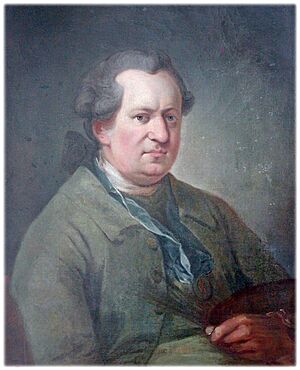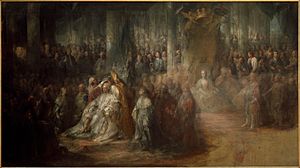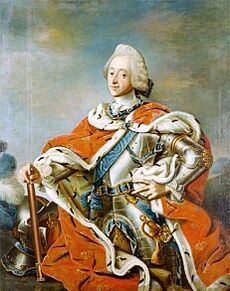Carl Gustaf Pilo facts for kids
Carl Gustaf Pilo (born March 5, 1711 – died March 2, 1793) was a famous Swedish artist and painter. He spent many years working in Denmark. There, he was a painter for the Danish Royal Family. He also taught art and was the director at the Royal Danish Academy of Art. Pilo is most famous for his amazing painting, "The Coronation of Gustaf III." King Gustav III of Sweden asked him to paint it.
Contents
Early Life and Training
Carl Gustaf Pilo was born on a farm in Runtuna Parish, near Nyköping, Sweden. His father, Olof Pilo, was also a painter. Carl Gustaf likely learned to paint from his father. His training probably started in Stockholm around 1723.
Pilo began his career as a craft painter. He became an apprentice in 1731. Some records say he traveled through Germany to Vienna between 1734 and 1736. However, other sources say he stayed in Scandinavia. They suggest he was a student at the new Swedish Drawing Academy in 1735. He probably worked as a craft painter from 1733 to 1738.
Starting His Career in Skåne
From 1738 to 1741, Pilo lived in Scania, a region in Sweden. He might have worked as a painter for two noble families there. He was known as a skilled portrait painter. He reportedly painted a large family picture for Countess Lewenhaupt. During these years, he created many portraits.
Moving to Denmark
In early 1741, Pilo moved to Copenhagen, Denmark. He started working as a drawing teacher at the National Cadet Academy on April 4, 1741. He taught the sons of noble families, royal pages, and cadets.
He continued to paint portraits in Denmark. In 1742, he painted a popular portrait of Crown Princess Louise of Great Britain. She was the future wife of King Frederick V of Denmark. He also painted Christian Jacobsen Drakenberg in 1742 and Christian Lerche in 1743. Pilo worked hard to improve his painting skills. In 1745, he became the supervisor of drawing instruction at the Academy. He also began painting portraits for King Christian VI of Denmark. Between 1745 and 1747, he started using the rococo art style in his work.
Success at the Royal Court and Academy
In 1747, Pilo became the official painter for King Frederick V of Denmark. His job also included taking care of and fixing paintings at the royal palaces. He became very busy, and many paintings came from his studio.
In 1748, Pilo became a professor at the Drawing and Painting Academy. This academy later became the Royal Danish Academy of Art. The Academy moved to Charlottenborg Palace and officially opened as the Royal Danish Academy of Art on March 30, 1754. Pilo gave the welcoming speech to King Frederick V. He also became a member of the Academy that same year.
Around 1757, a new art style called neoclassicism became popular. Pilo's paintings started to show more drama and focus on light and shadow. He also studied the works of famous Dutch painters like Rembrandt. French painter Louis Tocqué also inspired him when he visited Denmark.
Pilo taught drawing to Crown Prince Christian VII of Denmark in 1759. He became a member of art academies in Augsburg (1759) and St. Petersburg (1770). The royal court asked Pilo to paint many portraits of King Frederik V. Between 1748 and 1767, he painted more than 50 of them. Pilo became the leader of the Academy in 1771.
Downfall in Denmark
In 1771-1772, there was a strong feeling against foreign artists in Denmark. This was partly because of political changes and a coup in Sweden.
On August 31, 1772, Pilo received a special award from Sweden, the Cross of the Knight of the Order of Vasa. This award required him to promise loyalty to Sweden, his home country. This was a problem because he worked for the King of Denmark. Because of this, he lost his job.
On September 10, he was asked to travel to Schleswig to paint a portrait of the King's sister. Pilo refused this job and resigned. His resignation was accepted on September 17. This ended his more than 30 years of service to Denmark. On September 21, he was told to leave the country within a few weeks.
Return to Sweden
Pilo left Denmark in October 1772 and arrived in Stockholm in November. He visited the Ramel family in Skåne first. He was made an honorary member of the Royal Swedish Academy of Fine Arts in 1773. In 1775, he settled in his childhood town of Nyköping.
King Gustav III of Sweden asked him to paint his coronation. Pilo became the Director of the Swedish Academy in 1777. He started this job in 1780 and also received an apartment in Stockholm. He lived at the Academy and worked on his masterpiece, the painting of Gustav III’s coronation in Stockholm Cathedral. He continued working on it until he died.
Personal Life
Carl Gustaf Pilo married Charlotte Amélie Dorothée Desmarez on January 5, 1750. He died in Stockholm on March 2, 1793. He was buried at Klara Church.
See also
 In Spanish: Carl Gustaf Pilo para niños
In Spanish: Carl Gustaf Pilo para niños
- Art of Denmark





